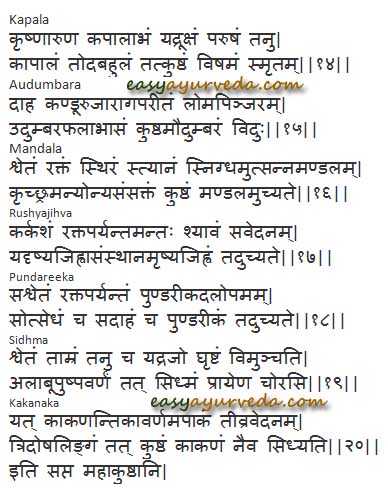Maha Kushta: Major Skin Diseases, Symptoms, Prognosis
Article by Dr Raghuram Y.S. MD (Ay) & Dr Manasa, B.A.M.S
Kushta means skin diseases. Depending on the nature of manifestation, complexities, the severity of presentation, prognosis and treatment options, the 18 types of Kushta have been sub-classified into
7 types of Maha Kushtas (major or greater skin diseases) and
11 Kshudra Kushtas (minor or lesser skin diseases).
Table of Contents
7 Maha Kushta
- Kaapaala (Kapala) Kushta
- Audumbara (Oudumbara) Kushta
- Mandala Kushta
- Rushyajihwa (Rishyajihwa) Kushta
- Pundareeka (Pundarika) Kushta
- Sidhma Kushta
- Kaakana (Kakana) Kushta

Kapala Kushta
Shape and appearance – Kaapaala means a piece of earthen pot, in the shape of a saucer. The Kushta in which the lesions or eruptions resemble a Kaapaala is called Kapala Kushta.
Signs –
- Krishna-Aruna Kapaalabham – The lesions are either Krushna (blackish brown, grey) or Aruna (yellowish red, Golden yellow) in color or a mix of Krishna and Aruna varnas (all colors mixed together). They appear like a piece of earthen pot which is freshly made, with a muddy shine (reddish black or blackish red).
- Rooksha-Parusham – They look dry (ruksha) and are rough and hard (parusham) on touch.
- Tanu – They are thin (not protruded), on the surface and in level to the skin surface
- Vishamam – Spreads abruptly, in a haphazard way
Predominant symptoms –
– Toda Bahulam – Typically characterized by excessive toda or pricking / throbbing pain
Dosha Predominance – Vata Dosha
Udumbara Kushta
Udumbara / Audumbara (Oudumbara) Kushta
Shape and Appearance – As the name indicates, this Kushta typically appears like a pakwa udumbara phala (ripe fruit of Ficus racemosa, Indian fig tree, and cluster fig tree)
Signs –
– Udumbara Phalabhasam – Appears like an Udumbara fruit
– Loma Pinjaram – The hairs in the region of kushta have golden yellow color
Predominant Symptoms
Daha – Burning sensation
Kandu – Itching
Rujaa – Pain
Raaga – Reddish discoloration
Dosha Predominance – Pitta Dosha
Mandala Kushta
Shape and Appearance – As the name indicates, this Kushta typically manifests in the shape of a Mandala, a circular raised patch.
Signs –
Shwetam – White in color
Raktam – Red colored
Sthira – Stiff, stable and unmovable
Snigdham – Unctuous, oily appearance, shiny
Utsannam – Elevated, raised over the surface of the skin
Mandalam – Circular in shape
Anyo anya samyuktam – Mingled with one another
Predominant Symptom – Styaanam – Feeling of heaviness in the site of lesion
Prognosis -Mandala Kushta is said to be Krichra Saadhya i.e. difficult to cure
Dosha Predominance – Kapha Dosha
Rushyajihwa Kushta
Rushyajihwa (Rishyajihwa) Kushta
Shape and Appearance – As the name indicates, this Kushta typically resembles the shape of the tongue (jihwa) of a Rushya / Rishya (type of deer or bear).
Signs –
Karkasham – Rough or coarse in appearance and touch
Rakta Paryantam – Red colored at the margins
Antaha Shyaavam – Bluish black at the centre
Rushya Jihwa Samsthaanam – Resembles the shape of the tongue of a deer or bear
Predominant Symptom: Vedana – Pain
Dosha Predominance – Vata-Pitta Doshas
Pundareeka Kushta
Appearance, Signs and Symptoms –
Shape and Appearance – As the name indicates, this Kushta typically resembles a Pundareeka dala or petal of red variety of Lotus flower.
Signs –
Shwetam – White in color
Rakta Paryantam – Red colored at the center
Pundareeka Dala Upamam – Resembles the petal of a red colored lotus
Sa Utsedham – Elevated from the surface of the skin (raised)
Predominant Symptom: – Daaham – Burning sensation
Dosha Predominance – Kapha-Pitta Doshas
Sidhma Kushta
Shape and Appearance – Sidhma Kushta resembles (has the color of) Alabu Pushpa (flower of Lagenaria sicareria)
Signs –
Shwetam – White in color
Tamram– Copper color
Tanu– Thin lesions
Alabu Pushpa Varnam – Resembles the flower or petals of the flowers of Lagenaria sicareria
Rajo Ghrishtam Vimunchati – The lesions yield dusty particles (of skin, skin peel) on rubbing or scratching
Predominant Symptom:
Rajo Ghrishtam Vimunchati – The lesions yield dusty particles (of skin, skin peel) on rubbing or scratching
Specific location – Praayena Urasi – Sidhma can occur anywhere, but it generally manifests on the chest
Dosha Predominance – Vata-Kapha Doshas
Kakana Kushta
Shape and Appearance – As the name indicates, this Kushta typically resembles the color of Kakanantika or Gunja (Abrus precatorius)
Signs –
Apaakam – The lesions do not get suppurated
Kaakanantika Varnam – Lesions resemble red color similar to that of seeds of Abrus precatorius
Predominant Symptom / Symptoms
Teevra Vedanam – Severe pain
Tridosha Lingam – Signs and symptoms of vitiation of all the 3 doshas can be seen in this Kushta
Prognosis – Asadhya – Kaakana Kushta is incurable
Dosha Predominance – vitiation of all the 3 doshas
Just Before Finishing –
The term Maha associated with Kushta means major or greater. They may possibly be involved with a difficult pathology and stubborn prognosis.
Medicines for Kushta from Sahasra Yoga Text Book
Kushtahara Kashaya
Sannipata vikarahara Kashaya
Masurikahara Kashaya
Hikkadihara Kashaya
Jirna Jwarahara Kashaya
Tiktaka Ghrita
Mahatiktaka Ghrita
Panchatiktaka Guggulu Ghrita
Dhanvantari Ghrita
Kalyanaka Ghrita
Maha Kalyanaka Ghrita
Guggulyadi Taila
Panchavalkadi Taila
Kushtantaka Taila
Tiphaladi Taila
Dinesavallyadi Taila
Kacchuradi Taila
Pathadi Choorna
Khandasama Choorna
Pridhu Nimba Panchaka Choorna
Hapushadi Choorna
Vyoshadi Choorna
Ayaskantadi Choorna
Guggulu Panchapala Choorna
Gandhaka Choorna
Narasimha Choorna
Dasamoolarishta
Khadirarishta
Dantyarishta
Duralabharishta
Manibhardra Guda
Danti Haritakyavaleha
Gandhaka Rasayana
Dasamooladi Lehya
Chitraka Guda
Brihat Madhusnuhi Rasayana
Khadiradi Rasayana
Kaisora Guggulu
Click to Consult Dr Raghuram Y.S. MD (Ayu)









